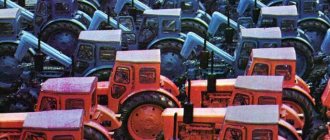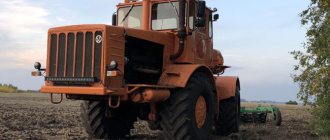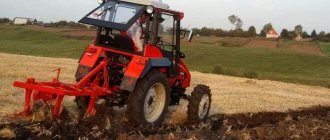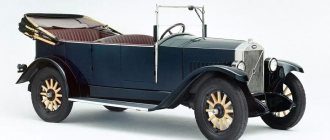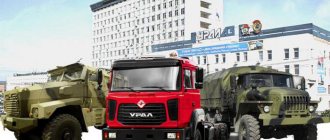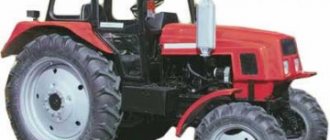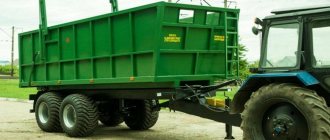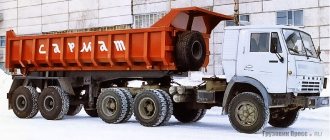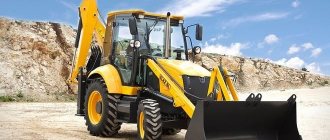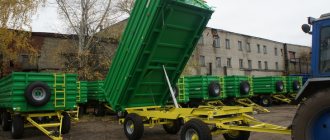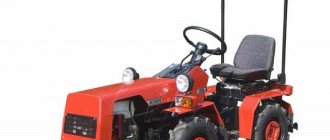At the end of the Great Patriotic War, there was an urgent need to replenish the fleet of row-crop tractors used in agriculture.
The KD-35 model was put into production in a short time. Haste is not a help; significant miscalculations were made during development.
Even modernization, where the KDP-35 modification appeared, did not help correct the situation. Realizing the shortcomings of the equipment being produced, specialists from the Lipetsk plant designed the T-38 tracked tractor.
It was based on the solutions used on the KDP-35 model; this is a qualitatively different technique. The tractor is not without its shortcomings, the main one of which was the insufficiently powerful power unit.
About company
The history of the Lipetsk Tractor Plant goes back to 1932, when highly specialized tool and mechanical shops were opened.
Within 7 years, the enterprise became one of the largest in Lipetsk, and in 1944, the Lipetsk Tractor Plant was created on its basis.
The first tractor to roll off the LTZ assembly line was the tracked “Kirovets-35” with a gasoline engine.
Subsequently, well-known models of row-crop tractors KD-35, T-38M, KDP-35, T-38 (tracked) and wheeled tractors T-40, LTZ-55, LTZ-60, LTZ-155 were produced in various modifications.
The modernized models, which appeared in the early 90s of the 20th century, were intended for soil cultivation and agricultural work on growing crops.
In combination with various additional implements, LTZ tractors were used for construction, road, and utility work, and were used as unloading and loading equipment.
The fate of the plant was such that after bankruptcy in 2004, the company was reorganized and was first part of the Tractor Plants concern, and later in Agromash OJSC as a subsidiary.
In recent years, attempts have been made to restore production of the updated LTZ-155 model together with partners.
From Kirovets-35 to LTZ-155. What equipment did the Lipetsk Tractor Plant produce?
It is often said about LTZ that the plant could become a Russian alternative to Belarusian MTZ tractors after the collapse of the USSR. But let's say it didn't work out that way. Let's go through the history of the Lipetsk Tractor Plant today to get to know what products the company produced at various stages of its development.
It’s not for nothing that they remembered MTZ tractors, because their history began with a small caterpillar tractor that moved to Minsk from Lipetsk. We are talking about Lipetsk “Kirov residents”. But let's take things in order.
At the end of the war, the food issue was acute. The state was able to mobilize and send specialists, including from the Red Army, to build a new Lipetsk Tractor Plant. The task was also set to create a new crawler tractor for agricultural needs.
In 1944, NATI developers created a row-crop tracked tractor with a traction class of 2 tons, “Kirovets-35” with a ZIS-5T gasoline engine. At this time, the development of a diesel engine intended for the Lipetsk Kirovets was also underway.
Since 1947, a diesel version of the tractor, the KD-35, . Production continued until 1960.
Model of the crawler tractor "Kirovets" (KD-35). The item was made by workers of the Minsk Tractor Plant as a gift to J.V. Stalin on his 70th birthday. From the collections of the State Central Museum of Contemporary History of Russia
The row-crop version of the Kirovets received the index KDP-35 . It should be noted that the first experimental diesel KD-35s were assembled back in 1943, but there was no suitable domestic engine for them yet. That's why they installed engines from Catterpillar.
Spraying a vineyard with a KD-35 tractor at the 2nd department of the Gelendzhik state farm. From the collections of the Gelendzhik Museum of History and Local Lore
In 1950, the Lipetsk tractors KD-35 and KDP-35 became the first-born of the young Minsk Tractor Plant and became the basis for the development of the first MTZ wheeled tractors.
In 1957, the T-38 .
1973 Preparing the T-38 tractor for work. In the photo, two students from the Belo-Kolodezskaya secondary school are refueling a tractor. From the collection of the Weidelevsky Museum of Local Lore
the T-38M retired .
The year 1958 can be considered the beginning of a new stage in the development of the Lipetsk Tractor Plant. The first wheeled vehicles began to be produced. At that time, these were mainly self-propelled chassis - SSh-27, SSh-30 and SSh-30A.
At the same time, tests were carried out on the T-25 wheeled row crop tractor, which began to be produced at LTZ in 1960 under the name T-30 . Then its more powerful modifications, the T-35, .
Very little time passed after the creation of the T-30 and T-35 when another model appeared in 1961. We are talking, I’m not afraid of this word, about the legendary business card of the Lipetsk Tractor Plant - the T-40 row-crop wheeled tractor. The legendary “magpie” lasted on the assembly line until 1995.
Its all-wheel drive version T-40A received the greatest success. There were a lot of modifications of the “magpie”, I will give just a few of them: the T-40AN tractor is low-clearance, the T-40AP is a utility tractor, the T-50A is an industrial tractor for working with a bucket (loader).
I can’t help but tell you about a very exotic version of the “magpie”. The T-40AL on an articulated frame was intended for work in forestry.
T-40s in various modifications are quite often found in private hands today. One of the most important disadvantages of this series was the working conditions in the cabin: noise, dust, vibration, microclimate. An attempt to solve this problem was the development of LTZ-55A in 1979. It was equipped with a safe frame vibration-isolated cabin with heating and ventilation.
LTZ-55A
Another problem with the “magpies” and their “comfortable” relative LTZ-55 were air-cooled engines. Only in the difficult 90s did the LTZ-60AV and LTZ-60AB with liquid-cooled engines with a power of 60 horsepower appear on the assembly line.
LTZ-60AV
LTZ-155 deserves a special mention .
LTZ-155
It, like its predecessors LTZ-100 and LTZ-145 , had rotating not only front wheels, but also rear ones. It was recommended for mass production back in 1991. Only in 1995 the first batches of the tractor appeared. It was planned to develop a weaker version of it with 100-120 horsepower, the LTZ-105 .
The LTZ-95 tractor has also been developed , which is unified to the maximum with the LTZ-155.
LTZ-95
It was distinguished primarily by its traditional layout and in the future the LTZ-95 could compete with the Belarusian MTZ-80/82.
And then bankruptcy and other delights of inept management of a company in a market economy struck. It is worth noting that the technical documentation for LTZ-155 was used for the development and production of the Uralvagonzavod RTM-160 tractor.
But even here, tractor production was quickly curtailed by 2009, despite the most positive reviews about the technology.
Technical characteristics of LTZ tractors
That's all, see you soon!!!
Similar
Model range overview
Based on the T-40 tractor, the LTZ-55 and LTZ-60 models, belonging to the 1.4 traction class, were developed in the early 90s.
The LTZ-55 wheeled tractor is a universal general-purpose machine with a power of 50 hp. It was produced until 2004.
Several modifications were produced: an all-wheel drive version with automatic engagement of the front axle LTZ-55A, a version with reduced ground pressure LTZ-55AL, a model with reduced ground clearance for work on steep slopes LTZ-55AN.
The universal LTZ-60 was produced until 2009. This model is distinguished by a 4x4 wheel arrangement, a rigid rear suspension, and a spring suspension at the front. Performs a wide range of agricultural, economic and construction work. Versions have been developed: LTZ-60AV with improved controllability and LTZ-60AB with increased hydraulic load capacity.
In addition, modifications were produced LTZ-60 with a low cabin, with diesel engines of water and air cooling and LTZ60ABL for work on wet soil.
Based on the LTZ-60, several models of excavators with various attachment configurations EO-2101 and EO-2621 were produced as specialized municipal equipment.
The plant produced a wide range of various additional devices and attachments.
The most promising model was considered to be the LTZ-155 tractor on an integrated circuit, with a three-point hitch, identical wheels and optimal axial weight distribution. The machine is suitable for operation in 2 modes – standard and economical.
The comfortable cabin has all-round glazing.
The new version of the LTZ-155U does not have a mechanism for turning the rear wheels, as a result of which the turning radius has increased to 5.6 m, and the cost of the vehicle has been reduced.
Model range Kirovets
The model range is represented by the main tractors that began to be produced after the 90s. At this time, the country was in dire need of improving the economy and units that could compete with Chinese and European products. A tractor was supposed to appear at an affordable price and quality not inferior to its European counterparts.
Kirovets K-424 “Premium”
Kirovets K 424
The development belongs to the modern line, since the model was introduced in 2015. The advantages include adaptability to domestic operating conditions and undemanding quality of fuel. This is the smallest wheeled machine in the entire line, which is most suitable for small agricultural farms. The design is equipped with a universal coupling device, which helps to connect a wide variety of attachments to perform the following work:
- Processing, plowing;
- Cultivation;
- Sowing, harvesting;
- Soil fertilization and more.
The tractor weight is 10 tons and with dimensions (lwh) 6.9 * 2.5 * 3.4 m, the turning radius is only 6.2 m. Advantages of the K424:
- Increased maneuverability, which is achieved through the use of an articulated frame.
- The design is balanced so well that the machine feels confident on any, even very difficult, surfaces.
- The wheelbase is designed in such a way that it allows movement on public roads.
- The engines are equipped with an electronic injection system, and also switch to economical fuel consumption when using maximum power.
- Superior cabin.
- The most powerful hydraulic system.
The K 424 tractor is equipped with an engine with a power of 240 hp. This is a 4-stroke diesel engine with 6 cylinders, which have a working volume of 6.6 liters. Naturally, such power is cooled using a liquid system.
Technical parameters and characteristics
The indisputable advantages of LTZ tractors are compact dimensions with fairly high power and traction force, good maneuverability, excellent maneuverability, high level of maintainability, availability and low cost of standardized spare parts, rational aggregation with a variety of mounted and trailed mechanisms.
LTZ tractors were equipped with high-quality, reliable diesel engines from leading motor plants, which have proven themselves well in other equipment (Rybinsk, Vladimir, Minsk motor plants).
A number of models were equipped with modernized engines with a reduced volume without loss of power.
The design of all-wheel drive models has a distinctive feature - under normal conditions the rear axle operates, all-wheel drive is activated automatically only on heavy ground.
Band-type brakes are installed with synchronous action on all wheels.
The speed of LTZ tractors is 30 -35 km/h. Thanks to the separate-module type hydraulic system, it is possible to easily install trailed implements of various types.
The weight of the machines and overall dimensions are significantly smaller compared to similar models from other manufacturers.
The creation of LTZ-155 made it possible to use the latest technologies for cultivating various crops.
Thanks to the aggregation of the tractor with a wide range of mounted units (18-row compared to 12-row on other tractors), the number of passes of equipment is reduced, labor productivity increases, fuel and herbicide consumption are reduced, and working resources are freed up.
The use of such agrotechnical methods ensures the preservation of the fertile soil layer and increases crop yields.
Features of operation and maintenance
Thanks to their sophisticated design, all LTZ tractors are distinguished by high reliability and durability of components and mechanisms. This is confirmed by the machines’ unpretentiousness to the quality of fuels and lubricants.
Thanks to the optimal technology of the machines and high quality assembly, tractors do not require running-in.
Following a standard maintenance schedule ensures continued operation without major overhauls. According to leading mechanical engineering designers, LTZ tractors are distinguished by their unique design and technological characteristics; similar models simply do not exist.
Thanks to high-quality assembly, rational access to the main mechanisms and systems, unification of components and parts, LTZ tractors are distinguished by good maintainability, durability and reliability.
It is not without reason that in some farms you can still find perfectly functioning tractors from the Lipetsk plant from the distant past, which are in no way inferior to modern models.
Today, on the used equipment market, LTZ tractors are offered in the range of 135-350 thousand rubles. depending on the year of manufacture and condition of the car.
LTZ tractors are not demanding on the quality of fuels and lubricants.
Modern synthetic and semi-synthetic diesel engine oils are used as motor oil, taking into account the operating season of the equipment.
Litol-24 is used to lubricate rubbing units and parts.
Maintenance, fuel consumption, and oil changes are carried out as standard.
You should regularly clean the tractor body from dust and oil stains, check the tire pressure, and adjust the clutch and brake pedals every 50-100 hours of operation.
At the end of field work, conservation is carried out, namely: the tractor is cleaned of dirt, dried, drained of oil and fuel, parts are lubricated to prevent corrosion from forming, covered and placed in a dry place.
Malfunctions and repairs
| The engine will not start: | Lack of oil or fuel; There is dirt in the air or fuel filter; The spark plug does not produce a spark; The carburetor is not adjusted correctly. |
| Brakes do not work: | The free play of the pedal has increased (adjust its position); The brake disc or pad is worn out (replace the relevant parts). |
| Starter does not work: | Broken or poor contact of the wire (solder or connect it); Weak battery charge (charge it); Short circuit (clean the commutator surface or replace the brushes); Poor contact of the magnetic switch (tighten the switch travel by 2-3 turns). |
Among the most significant breakdowns, owners note insufficient technological development of the clutch studs.
The increased power of modernized engines does not fit well with their design, which leads to premature failure.
There are fuel and oil leaks.
Among the shortcomings is the mediocre level of comfort in the cabin for the driver of the LTZ-55.
Versions LTZ-60, LTZ-155 are more ergonomic. But, as the tractor drivers themselves note, the price corresponds to the comfort.
Owner reviews
Nikolay , Smolensk: “I have a lot of equipment on my farm. But the most reliable is the LTZ-60av tractor. Water-cooled engine from the Rybinsk Motor Plant. I changed the seat and installed a car heater, and made a window. I haven’t changed anything from the main mechanisms, everything is original and works.” Peter : “The iron machine is a reliable machine. Change parts and work again. You can’t go far with today’s plastic toys, it’s somehow unreliable. If you compare the price of LTZ, it is quite consistent with the characteristics. Various improvements in the cabin can be made to suit your needs, but there are no shortcomings in the main design” Alexander , Lipetsk region: “I bought the LTZ155 tractor back in 2002 from the factory. Then the latest models were already on their way. There were enough shortcomings of all sorts, I had to tinker with it myself. But during the entire period of operation there were no serious breakdowns"
Tractor T-38: modifications and main parameters
At the end of the Great Patriotic War, there was an urgent need to replenish the fleet of row-crop tractors used in agriculture.
The KD-35 model was put into production in a short time. Haste is not a help; significant miscalculations were made during development.
Even modernization, where the KDP-35 modification appeared, did not help correct the situation. Realizing the shortcomings of the equipment being produced, specialists from the Lipetsk plant designed the T-38 tracked tractor.
It was based on the solutions used on the KDP-35 model; this is a qualitatively different technique. The tractor is not without its shortcomings, the main one of which was the insufficiently powerful power unit.
On pure enthusiasm
By the beginning of 1943, a twofold situation had developed. On the one hand, due to the gradual wear and tear of existing equipment both in agriculture and at the front, an urgent need for tractors arose. On the other hand, during the war a turning point came, and the state had the opportunity to allocate funds for the restoration and development of industry.
NATI was entrusted with the development of a medium-power caterpillar tractor that could be used both for arable and row cropping. At the same time, in Lipetsk, based on the surviving buildings of Stankostroy, the construction of a plant began to produce a new model.
Of course, establishing production in wartime conditions is not an easy task. There were not enough funds and equipment. The plant did not have steel casting shops, so many parts had to be imported from other enterprises. There were no machines for cold stamping. Instead, some parts were simply cut out by hand.
There weren't enough staff either. Designers, technologists, and workers at tractor factories were recalled from the ranks of the Red Army. Many of the employees of the new enterprise were private soldiers who returned from injury. In fact, both construction and production were based on the same enthusiasm. However, the plant was restored as soon as possible and by the end of 1944 it produced 5 cars.
Parameters and technical specifications
To evaluate the T-38 tractor, it is worth studying the technical characteristics and design description. The popular model was equipped with:
- Torsion bar suspension of crawler bogies, where the operator was provided with comfort.
- Double final drives with additional gearboxes, increasing the clearance to 610 mm.
- Tapered roller bearings protected from dirt by mechanical seals. Lubricant for these bearings was supplied through a special centralized system. Thanks to this feature, the maintenance time for the chassis was reduced by 3–4 times.
- Separately aggregated mounted system, operating due to one or two remote cylinders. This made it possible to equip the T-38 tractor with mounted and towed agricultural equipment.
- Power take-off shaft of dependent type with constant speed.
- A manually controlled transmission with five forward gears and one reverse gear, where a speed of 9.7 km/h was reached.
- A set of tracks: standard, 200 mm wide, and additional 280 mm wide. The latter operated the machine on loose soil.
- Diesel power unit D-40 with a capacity of 45 hp. s., torque 16.3 kgm. The launch was carried out using a PD-10M gasoline starting engine.
Attention has been paid to lowering the center of gravity. Feedback from those who had the chance to operate this model speaks unequivocally: the tractor moved across the arable land and, with the experience of the operator, overcame obstacles.
It is no coincidence that the tractor was chosen as the vehicle serving the famous drifting station North Pole-13. Still, the energy supply was not enough.
The KD-35, tracked, 2-ton class tractor and the KDP-35 tractor, created on its basis, have much in common. The design of the engine, radiator, transmission (except for the final drive), controls and other components and parts, as well as the location of individual units and components on the KDP-Z5 tractor remained the same as on the KD-35 tractor. Both tractors are made according to the usual design for agricultural machines with a front-mounted engine and rear-mounted drive wheels. Tractors of frame construction. In the front part, a water radiator and an oil radiator mounted on its front plane are installed on the tractor frame. Directly behind the water radiator on the frame there is an engine with a clutch. The clutch is of a non-permanently closed type, single-disc, dry, mounted in a special crankcase. At the rear of the tractor, a gearbox, central gear and final drives are installed, which are mounted in separate housings and represent separate complete mechanisms. The gearbox is three-way, five-speed, with direct transmission at fifth speed. The gearbox is connected to the clutch via a flexible coupling. The rear axle includes a central gear, a tractor steering clutch and brakes mounted on the rear axle shaft in a common housing. The rear axle includes a central gear, a tractor steering clutch and brakes mounted on the rear axle shaft in a common housing. The driving (small) bevel gear is made in one piece with the secondary shaft of the gearbox, and the driven (large) bevel gear with its hub is mounted on a cone in the middle part of the rear axle shaft and tightened with a special nut with a lock washer. The rotation couplings are multi-disc, dry, mounted on the ends of the rear axle shaft in the side compartments of the rear axle housing. The brakes are band type, with steel bands, the brakes are controlled by pedals. The final drive of the KD-35 tractor is single-stage, with one pair of cylindrical gears (small driving and large driven) with straight teeth, enclosed in a common housing. The tractor frame with the units and components installed on it rests on the tractor chassis at three points. The tractor chassis consists of right and left caterpillar bogies, pivotally connected to the tractor frame and two caterpillar chains. The crawler bogie has a frame of welded structure, on which are mounted: four road wheels at the bottom, a guide wheel at the front and a tensioner at the top. In the front part, the tractor frame rests on bogies through a front suspension with a balancer and a transverse spring. The track chain of each cart consists of 31 links, hingedly connected using pins. The track link is a cast steel plate with a transverse rib (for engagement with the soil) and an upper ridge (for engagement with the final drive sprocket). The traction device is of a pendulum type, the central rod is pivotally attached to the frame under the gearbox and rests on a transverse strip fixed in the bosses of the rear frame brackets. The power take-off shaft and drive pulley are installed on the rear wall of the rear axle housing. To illuminate the tractor, there are three headlights: two front ones are attached to the radiator and one rear one is attached to the cab. In the first half of 1959, the KD-35 tractor was modernized. It has significantly increased the reliability of the chassis due to the introduction of roller bearings and rubber-metal seals in the rollers and idler wheels, a device has been introduced that prevents the divergence of tracked bogies, and special shock absorbers have been installed that reduce the swaying of the tractor when working with mounted implements. Engine power increased to 45 hp. by increasing the speed from 1400 to 1600 rpm. Tractor KD-35 "Kirovets"Design features of the KDP-35 tractor. The increase in the tractor track width and ground clearance (compared to the KD-35 tractor) was achieved due to a complete change in the design of the final drive and partial changes in the design of the chassis, frame, front suspension and rear axle. The rear axle of the KDP-35 tractor (compared to tractor KD-35) has the following changes: the large bevel gear of the central transmission has been moved to the left side, which was achieved by rotating the rear axle shaft by 180°; The design of the lever mechanism that transmits the tightening force from the pedal to the brake strap has been changed; an enlarged platform for installing a hydraulic lift has been provided on the rear wall of the rear axle housing. The final drive is two-stage, with two pairs of spur gears located in three housings, bolted together. To reduce the forces acting on the power transmission, an unloading device in the form of a rubber buffer was introduced. The tractor can be equipped with two types of tracks: 280 mm wide (standard on the KD-35 tractor) and a special, narrow one with a slab width of 200 mm. To ensure the ability to work with mounted and semi-mounted agricultural machines and implements, the KDP-35 tractor is equipped with the NS-37 mounted system, consisting of a hydraulic mechanism, a control mechanism and a linkage mechanism.
Technical characteristics of tractors KD-35 and KDP-35
| KD-35 | KDP-35 | |
| Tractor type | Agricultural general purpose | universal, row crop |
| Traction force (in first gear), kg | 1750 | 1750 |
| Tractor weight (structural), kg | 3700 | 4100 |
| Overall dimensions, mm: | ||
| ..length | 3080 | 3100 |
| ..width | 1430 | 1700 |
| ..height (at the radiator neck) | 1420 | 1755 |
| Ground clearance, mm | 275 | 640 |
| Track (distance between the middle of the tracks), mm | 1090 | 1340 |
| Specific pressure on soil, kgf/cm2 | 0,5 | 0,6 |
| Number of gears: | ||
| ..forward | 5 | 5 |
| ..back | 1 | 1 |
| Speed range, km/h: | ||
| ..forward | 3,81 — 9,11 | 3,78 — 9,05 |
| ..back | 3,54 | 3,52 |
| Engine make | D-35 * | D-35 |
| engine's type | Diesel, compressorless, with a swirl chamber and compression ignition | — |
| Rated power, hp | 35 | 40 |
| Maximum power, hp | 40 | 45 |
| Maximum torque, kGm | 14,8 | 16,3 |
| Fuel tank capacity, l | 115 | — |
| Starting the engine | PD-10M starting engine and decompressor | — |
* - Since the first half of 1959, the D-40 engine has been installed on the KD-35 tractor.
Further modification
The developers took into account the main shortcomings of the brainchild, made a number of improvements, and in 1961 the next modification appeared - the T-38M tractor.
The main thing was to increase the power of the power unit to 50 hp. With. The maximum speed increased to 10.3 km/h.
The upgrades made did not improve the performance of the machine. Nevertheless, they were produced for a long time at the Lipetsk and Vladimir plants, producing a total of 26,300 units in the T-38 modification, 103,800 units in the T-38M modification.
Having been on the assembly line from 1958 to 1973, it gave way to modern and productive technology.
Design competition
By the spring of 1944, NATI had developed a model of the Kirovets-35 tracked tractor. On April 23, two prototypes were brought to Lipetsk for field testing. However, the plant designers, led by B.E. Arkhangelsky, believed that they could compete with the capital’s engineers.
They were developing their own prototype of an experimental machine. Due to a lack of equipment, the work was carried out in an almost artisanal way. Many details were made and finished by hand. But despite all the difficulties, on June 1, 1944, the first Lipetsk-assembled Kirovets-35 with a carburetor engine was released.
The model was put into production, but the designers’ work did not end there. The need to convert the country's tractors to diesel fuel has been long overdue. It was cheaper and had higher efficiency than kerosene. In the summer of 1944, two experimental KD-35 diesel tractors were assembled at the Lipetsk plant. One of them had a D-35 engine sent from NATI, and the other had an engine from the American “Katepiller D2”.
On well-deserved rest
Today, the once popular model is found in museums and on pedestals.
The interest is not practical, but historical. Since production of the machine has long been discontinued, problems with maintenance and spare parts make operation impractical.
You can’t find reviews online about the performance of this once widespread technique. After all, the machine operators who used them have long since retired, as has the T-38 tractor itself. But the memory of the veteran of the domestic mechanical engineering is still alive.
